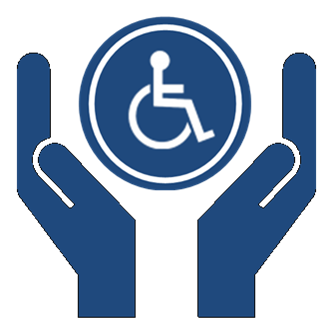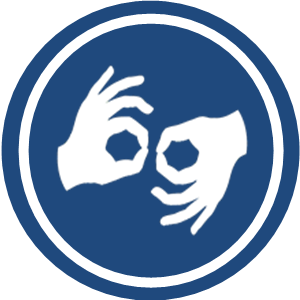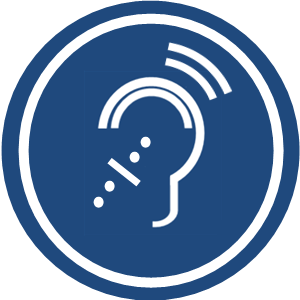Supporting Students Who Are Deaf or Hard of Hearing
Meaghan Barrett
Abstract
![]() In America, every 1.7 babies out of 1000 are born deaf or hard of hearing (Khalsa & Chan, 2023). Hearing loss can be defi ned as the inability to hear, whether partial or full, out of one or both ears. It is important for educators to know and understand how to support students who are deaf and hard of hearing, as most of these students are within mainstream classrooms. There are many reasons why students in elementary schools and secondary schools require Individual Education Plans (IEPs), and hearing loss is one reason that can be accompanied by other reasons.
In America, every 1.7 babies out of 1000 are born deaf or hard of hearing (Khalsa & Chan, 2023). Hearing loss can be defi ned as the inability to hear, whether partial or full, out of one or both ears. It is important for educators to know and understand how to support students who are deaf and hard of hearing, as most of these students are within mainstream classrooms. There are many reasons why students in elementary schools and secondary schools require Individual Education Plans (IEPs), and hearing loss is one reason that can be accompanied by other reasons.
The purpose of this chapter is to acknowledge possible barriers that students who are deaf or hard of hearing may encounter in a learning environment and provide recommendations for educators supporting these students. This chapter will focus on multiple studies and provide strategies and technologies to better support students who are deaf or hard of hearing.
Introduction
![]() Historically, students who were deaf and hard of hearing did not start receiving support until they reached the ages of 10 – 12 (Gallaudet University, n.d.). In 1867, the United States of America introduced two new schools, the Lexington School for the Deaf in New York City and the Clarke Institution for Deaf-Mutes in Northampton, Massachusetts, to teach students with hearing impairments how to read lips (O’Connor, 1951). Now, it is common to find students who are deaf and hard of hearing within public schools.
Historically, students who were deaf and hard of hearing did not start receiving support until they reached the ages of 10 – 12 (Gallaudet University, n.d.). In 1867, the United States of America introduced two new schools, the Lexington School for the Deaf in New York City and the Clarke Institution for Deaf-Mutes in Northampton, Massachusetts, to teach students with hearing impairments how to read lips (O’Connor, 1951). Now, it is common to find students who are deaf and hard of hearing within public schools.
From a study conducted between 2016 and 2021, looking at 49,340,700 children in America between the ages of six and 17, 1.4% were identified by parents as having hearing problems or deafness (Khalsa & Chan, 2023). Of these students, it was noted that children with hearing loss or troubles have lower school engagement in areas such as attendance, academic performance, clubs, and sports (Khalsa & Chan, 2023). It is important to acknowledge that students with hearing loss attend more medical appointments than typical learners, adding to low attendance.
Students who are deaf and hard of hearing often receive IEPs to support their learning within elementary and secondary schools. These IEPs are often accepted and tweaked by universities and colleges. On these IEPS, students often receive accommodations that are specific to hearing and may include frequency modulation (FM) systems, access to a deaf and hard of hearing teacher, and seating with close proximity to the instructor (Khalsa & Chan, 2023). Medically prescribed assistive devices, such as cochlear implants and hearing aids, may be mentioned on IEPs, too.
Behaviour challenges are also heightened with students who suffer from hearing loss. Students may appear to be more distracted or inattentive during a lesson due to their hearing impairments (Khalsa & Chan, 2023). It is important for educators to keep this in mind when planning engaging lessons for all students of different ability levels within the classroom.
Findings
 It is noted that students who are deaf or hard of hearing may also be diagnosed with multiple disabilities, such as cerebral palsy or vision loss (Thomas & Marvin, 2015). Consistent early interventions are important between the ages of zero and three, and monitoring progress is essential; however, many teachers of deaf and hard-of-hearing students do not consistently monitor progress due to a lack of time, tools, and training (Thomas & Marvin, 2015). Staff would benefit from more professional development training focusing on monitoring students’ progress and an opportunity to network with other professionals. Teachers of deaf and hard-of-hearing students are encouraged to make data-informed decisions to support interventions and collaborate with parents and other service providers (Thomas & Marvin, 2015). Placing students who are deaf and hard of hearing in a mainstream setting without the proper supports or technologies in place will lead to emotional distress and withdrawn behaviours (O’Connor, 1951).
It is noted that students who are deaf or hard of hearing may also be diagnosed with multiple disabilities, such as cerebral palsy or vision loss (Thomas & Marvin, 2015). Consistent early interventions are important between the ages of zero and three, and monitoring progress is essential; however, many teachers of deaf and hard-of-hearing students do not consistently monitor progress due to a lack of time, tools, and training (Thomas & Marvin, 2015). Staff would benefit from more professional development training focusing on monitoring students’ progress and an opportunity to network with other professionals. Teachers of deaf and hard-of-hearing students are encouraged to make data-informed decisions to support interventions and collaborate with parents and other service providers (Thomas & Marvin, 2015). Placing students who are deaf and hard of hearing in a mainstream setting without the proper supports or technologies in place will lead to emotional distress and withdrawn behaviours (O’Connor, 1951).
Similar to typical children, the first five years of language development are extremely important for children who are deaf and hard of hearing (O’Connor, 1951). The Accessibility for Ontarians with Disabilities Act (AODA, 2005) states that students and adults require barrier-free communication, allowing for service animals in schools and workplaces, and universal access, in addition to staff training. While many writing interventions are proposed to support learners who are deaf and hard of hearing, many lack the design or evidence to support learning disabilities (Strassman & Schirmer, 2012). Strassman and Schirmer (2012) acknowledge that the majority of studies conducted on writing instructions are based on typical students, and adaptations for instruction are often applied to students who are deaf or hard of hearing without research or testing first.
Supporting Learners within the Classroom
 There are many ways that staff can support students who are deaf or hard of hearing within the classroom. One tool is to start by reviewing the student’s IEP from a previous year. While reviewing the IEP, a teacher can look to see what strategies were used to support the student previously, as well as when assistive technologies they are familiar with were used. Often, students who are identified as having hearing loss will already have a deaf or hard-of-hearing teacher connected to them. When requested, this teacher can support the classroom teacher with implementing strategies on the IEP, team teach, and interpret hearing test results provided by doctors and families.
There are many ways that staff can support students who are deaf or hard of hearing within the classroom. One tool is to start by reviewing the student’s IEP from a previous year. While reviewing the IEP, a teacher can look to see what strategies were used to support the student previously, as well as when assistive technologies they are familiar with were used. Often, students who are identified as having hearing loss will already have a deaf or hard-of-hearing teacher connected to them. When requested, this teacher can support the classroom teacher with implementing strategies on the IEP, team teach, and interpret hearing test results provided by doctors and families.
Teachers must ensure their classroom is a welcoming environment. Students are to be free from discrimination, respected, and entitled to equality and dignity (Ontario Human Rights Commission, 2016). Teacher interventions remain a crucial support for students with hearing loss. Even with diagnosing hearing loss ten years sooner, students with hearing loss are still behind their peers with regard to phonological awareness, their letter-sound knowledge, and their vocabulary (Harris et al., 2017). Early interventions are recommended to support students with these skills.
Communicating Effectively
 As a teacher of students who are deaf or hard of hearing, it is extremely important to ensure that communication in the classroom is effective. Teachers are encouraged to ensure they have students’ attention prior to speaking to them by calling their names, waving, or tapping them on the shoulder (UTSA, n.d.). Teachers are also encouraged to pause and rephrase important information instead of repeating the important facts to ensure understanding (UTSA, n.d.).
As a teacher of students who are deaf or hard of hearing, it is extremely important to ensure that communication in the classroom is effective. Teachers are encouraged to ensure they have students’ attention prior to speaking to them by calling their names, waving, or tapping them on the shoulder (UTSA, n.d.). Teachers are also encouraged to pause and rephrase important information instead of repeating the important facts to ensure understanding (UTSA, n.d.).
ASL Interpreters
 Lip reading is a strategy for some people who are deaf or hard of hearing, but it is important to acknowledge that only 25% of speech can be read from the lips alone (UTSA, n.d.). To ensure the whole message is being understood, ASL interpreters can be used. When converting with the support of the ASL interpreter, it is important to continue to face and make eye contact with the person you are speaking with instead of the ASL interpreter, as the ASL interpreter is not part of the conversation (UTSA, n.d.).
Lip reading is a strategy for some people who are deaf or hard of hearing, but it is important to acknowledge that only 25% of speech can be read from the lips alone (UTSA, n.d.). To ensure the whole message is being understood, ASL interpreters can be used. When converting with the support of the ASL interpreter, it is important to continue to face and make eye contact with the person you are speaking with instead of the ASL interpreter, as the ASL interpreter is not part of the conversation (UTSA, n.d.).
Assistive Hearing Devices
 Many people who are deaf and hard of hearing communicate with the help of American Sign Language (ASL), lip reading, and/ or hearing devices (UTSA, n.d.). Hearing devices often support students within the classroom and the community. It is common to see students using hearing aids, but also cochlear implants and FM systems. Cochlear implants are permanent and attached to the head. They help sound bypass the inner ear, reaching and stimulating the auditory nerve (Zeng, 2004). A cochlear implant can be implanted in infants as young as three months old (Zeng, 2004). There are many benefits to using this technology, including users having up to 80% accuracy in speech recognition (Zeng, 2004). Early implantations will enhance speech acquisition in young children (Zeng, 2004), but the device struggles to support users with pitch and melody when listening to music. FM Systems work with a microphone that amplifies the speaker’s voice through a sound box. These FM systems are an excellent support in larger rooms that have a large number of people in them. It will help the learner or employee to hear over other distractions in the room.
Many people who are deaf and hard of hearing communicate with the help of American Sign Language (ASL), lip reading, and/ or hearing devices (UTSA, n.d.). Hearing devices often support students within the classroom and the community. It is common to see students using hearing aids, but also cochlear implants and FM systems. Cochlear implants are permanent and attached to the head. They help sound bypass the inner ear, reaching and stimulating the auditory nerve (Zeng, 2004). A cochlear implant can be implanted in infants as young as three months old (Zeng, 2004). There are many benefits to using this technology, including users having up to 80% accuracy in speech recognition (Zeng, 2004). Early implantations will enhance speech acquisition in young children (Zeng, 2004), but the device struggles to support users with pitch and melody when listening to music. FM Systems work with a microphone that amplifies the speaker’s voice through a sound box. These FM systems are an excellent support in larger rooms that have a large number of people in them. It will help the learner or employee to hear over other distractions in the room.
Although hearing tools such as hearing aids, FM Systems, and Cochlear Implants have huge impacts on the listeners, it is still important for speakers to keep in mind who may need more support in their environment. Even with these technologies, speakers should be close to the users and, as much as possible, face the listeners. They should also try to have small group discussions to check for understanding with the individuals in a quiet environment (UTSA, n.d.). When reading, it is important to ensure the reader’s face is not covered by a book or obstacle and to sit on the side of the ear with less hearing loss.
Whenever there is a video playing on a computer, teachers are strongly encouraged to turn on subtitles so a student or adult with hearing loss has the option to read along the screen for better understanding. This will help them to better understand conversions happening on the screen. This can take the form of YouTube videos with transcribed features as well as movies and TV shows with subtitles.
Cochlear Implants are often recommended by medical professionals who do not have strong ties to the deaf and hard-of-hearing community (Lane & Bahan, 1998). Parents often become misinformed that cochlear implants are the only option for success, often removing users from the ASL community (Lane & Bahan, 1998). Cochlear implants can be used in conjunction with ASL.
Technology within the classroom can also support students with hearing loss. Google Read and Write (TextHelp, n.d.) can be used to read to students when they have a microphone plugged into their Chromebooks. It can also participate in voice-to-text to support a student who may struggle with phonological awareness and vocabulary in their writing. Google Word Predict (TextHelp, n.d.) can also support students with their vocabulary if they are struggling to think of a word. Using these tools often supports students with a task by making a lesson more accessible. In turn, behaviours appear less as all students are engaged in the learning.
Conclusion
There are a lot of different ways to support learners who are deaf or hearing. It is important for educators and employers to remember that more strategies and tools are better for supporting learners and employees. Both hearing aids and cochlear implants are excellent devices for supporting hearing loss, but they work even better together (Zeng, 2004). When creating a workplace or classroom environment, it is important for staff and educators to implement as many strategies as possible, as it is possible that there are students or employees who have not disclosed their hearing loss to their school or employers. It is important to make the learning environment and / workplace as inclusive as possible. Teachers and employers should remember that hearing impairments do not correlate with intelligence and speech abilities (UTSA, n.d.).
References
Accessibility for Ontarians with Disabilities Act, S.O. 2005, c. 11. https://www.ontario.ca/laws/statute/05a11
Gallaudet University. (n.d.). Oral schools form on the principle of “pure oralism.” In History Through Deaf Eyes: Language and Identity. Gallaudet University Museum. https://gallaudet.edu/museum/exhibits/history-through-deaf-eyes/language-and-identity/o ral-schools-form-on-the-principle-of-pure-oralism/
Harris, M., Terlektsi, E., & Kyle, F. E. (2017). Literacy outcomes for primary school children who are deaf and hard of hearing: A cohort comparison study. Journal of Speech, Language, and Hearing Research, 60(3), 701–711. https://doi.org/10.1044/2016_JSLHR-H-15-0403
Khalsa, I. K., & Chan, D. K. (2023). Hearing Impairment and School Engagement Outcomes in US Children. JAMA otolaryngology– head & neck surgery, 149(12), 1091–1100. https://doi.org/10.1001/jamaoto.2023.2897
Lane, H., & Bahan, B. (1998). Ethics of cochlear implantation in young children: A review and reply from a Deaf-world perspective. Otology & Neurotology, 19(6), 714–720.
O’Connor, C. (1951). XCII: The deaf and hard of hearing child. American Annals of the Deaf, 96(1), 1039–1044. doi:10.1177/000348945106000416
Ontario Human Rights Commission. (2016). Policy on accessible education for students with disabilities. https://www.ohrc.on.ca
Strassman, B. K., & Schirmer, B. (2012). Teaching Writing to Deaf Students: Does Research Offer Evidence for Practice? Remedial and Special Education, 34(3), 166-179. https://doi-org.uproxy.library.dc-uoit.ca/10.1177/0741932512452013
TextHelp. (n.d.). Read&Write for education – reading, literacy & assistive software. Texthelp. https://www.texthelp.com/products/read-and-write-education/
Thomas, A. E., & Marvin, C. A. (2016). Program Monitoring Practices for Teachers of the Deaf and Hard of Hearing in Early Intervention. Communication Disorders Quarterly, 37(3), 184-193. https://doi-org.uproxy.library.dc-uoit.ca/10.1177/1525740115597862
UTSA. (n.d.). Tips for teaching students who are deaf or hard of hearing. The University of Texas at San Antonio. https://www.utsa.edu/disability/faculty-staff/tips-teaching-deaf.html
Zeng, F.-G. (2004). Trends in Cochlear Implants. Trends in Amplification, 8(1). https://doi.org/10.1177/108471380400800102
